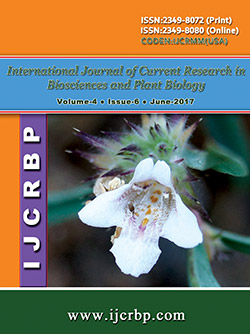 |
Online ISSN : 2349-8080 Issues : 12 per year Publisher : Excellent Publishers Email : editorinchiefijcrbp@gmail.com |
Cassava (Manihot esculenta Crantz) is one of the major root and tuber crops contributing to food security and poverty alleviation in Togo. Unfortunately, its cultivars diversity is still not known and has even never been assessed and documented countrywide for use in breeding and development programs. To fill this gap of knowledge, 40 villages randomly selected within cassava production zones in Togo were surveyed using participatory rural appraisal. A total of 168 farmer-named cultivars were recorded. Their number varied from 1 to 15 (7 on average) per village. The highest diversity in the surveyed area was found at M'poti (15 cultivars) in Centrale region while the lowest diversity was found at Awounadjassi (1 cultivar) in plateaux region. The Shannon-Weaver diversity index (H) was estimated at 3.59 bits.The folk nomenclature was analysed and understood. The distribution and extent analysis revealed that per village few cultivars (0 to 4) are produced by many houses on large areas. The rates of cultivars abandonment risk varying from 14% to 86% (44.87% on average) depending on the village. Low productivity, late maturity and toxicity were the main abandonment reasons reported by farmer. Subject to synonymy, the participatory evaluation of the 168 cultivars inventoried yielded 37 tolerant to poor soils, 29 tolerant to high soil moisture (adaptability to lowlands), 58 tolerant to drought and 57 tolerant to weeds.The majority (132 cultivars) of cultivars were well adapted to all type of soil, 119 were able to make good quality of chips whereas 123 cultivars were non-toxic. As cassava is a vegetative propagated crop and cultivars’ vernacular names vary across ethnic groups, it was recommended that the diversity be collected and fully characterized and synonymies clearly established. The results were found as of high importance for research and development actions including ex situ and in situ on farm conservation.
